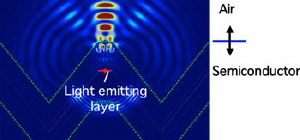Mar 17 2009
XueLun Wang, the Near Field Nano Engineering Group, the Nanotechnology Research Institute of the National Institute of Advanced Industrial Science and Technology (AIST) and Mutsuo Ogura, the Nanotechnology Research Institute, have jointly discovered the phenomenon that more than 50% of the spontaneous emission light generated in semiconductors with microscopic V-grooves is emitted into the air, and have succeeded in explaining the mechanism involved in cooperation with a group in the Paris Institute of Nanosciences, the National Center of Scientific Research (CNRS).
 Simulation results showing the efficient extraction of light genertaed in the light-emitting layer to air through the small top flat parts between the V-grooves.
Simulation results showing the efficient extraction of light genertaed in the light-emitting layer to air through the small top flat parts between the V-grooves.
Strong total internal reflection normally occurs at the interface between the semiconductor and the air because the refractive index of a semiconductor material is usually much greater than that of air. This makes it very difficult to efficiently extract spontaneous emission generated in a semiconductor material into the air. For example, in the case of semiconductor light-emitting materials formed on a flat substrate, one can only extract a few percent of the total emission generated. This is a serious roadblock to improving the efficiency of various semiconductor optical devices, such as LEDs.
In this study, semiconductor light-emitting materials are formed on substrates with microscopic V-grooves. By controlling the grooves shape, more than 50% of light generated is successfully extracted to air. When the light produced in the semiconductor material is totally reflected at the semiconductor-air interface, evanescent waves are generated. Due to the V-shaped surface structure of the material, evanescent waves originated from different crystal surfaces interfere with each other, and are transformed into light propagating in air with an efficiency of greater than 50%. This phenomenon will find applications in various types of semiconductor optical devices, especially LED, a promising device for future energy-efficient lighting and display applications.
The result of the study will be published in the electronic version of Applied Physics Letters on March 2, 2009.